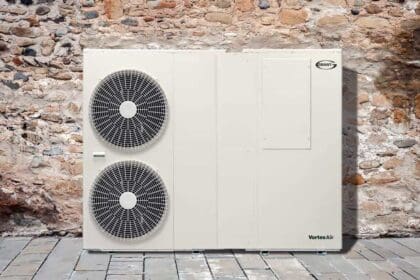
However, the application of Heat Pumps on a wider retrofit basis, to reduce energy costs and carbon emissions for existing buildings and processes, can be restricted due to the ‘lower than a boiler’ output temperatures of conventional Heat Pumps.
In order to overcome this application restriction High Temperature Heat Pumps are now available that can provide an answer to this temperature-based problem on both retrofit and new installations. With output temperature capability of over 80°C this next generation of Air or Ground/Water Source Heat Pumps can provide an energy and carbon saving solution for both commercial & industrial retrofit or new build applications.
Applications now include Oil or LPG Boiler replacement, District Heating schemes, Hot Water Generation and realistically any industrial or commercial heating/hot water application where energy cost savings and carbon savings are required.
Garry Broadbent of the specialist Heat Pump provider Pure Thermal commented, ‘We are now seeing an increase in demand for Higher Temperature systems for both heating and hot water production’, continuing, ‘the decreasing carbon content of grid electricity is favourable to Heat Pumps meaning that on a carbon saving basis a Heat Pump now stands up extremely well against fossil fuels’.
It is also very interesting that Heat Pumps also provide Cooling which means that these systems can now be considered within retrofit energy saving projects.
Basically a site that utilises cooling for Process or Air-conditioning usually despatches the valuable zero carbon heat generated by the cooling process to atmosphere as waste, however the overview below describes a High Temperature Heat Pump that is providing Production Cooling along with a 70C hot water output.
Garry Broadbent explains, ‘We are now designing systems where the Chiller/Heat Pump is providing cooling by operating alongside existing chillers, consuming a lower level of energy than the existing plant, and importantly also providing high temperature heat for hot water production, ‘he continues,’ for example a dual output 100kW Heat Pump/Cooling unit can also deliver, FREE and ZERO CARBON, 130kW of hot water which means that significant savings can be achieved with an attractive payback period on the retrofit investment by displacing the energy consumed by conventional fossil fuel heat sources’.
This retrofit opportunity is applicable to any application where a site has a duplicated demand for both cooling and hot water production, the message being that it is now practical to generate valuable low carbon high grade hot water as a by-product of cooling.
Basically in this example the energy to deliver cooling is providing two outputs, cooling & hot water, rather than simply providing cooling only which certainly puts a different slant with regard to the potential for heat pump application i.e. 1 x cooling input energy = 2 x outputs: cooling + hot water.
Within all of these potential applications summarised above it is clear that Heat Pumps as an alternative form of heating & hot water production are well proven and practical to both apply and use. An increasing focus on Heat Pumps as the most efficient form of electric heat source means that the use of this form of renewable technology will only increase as the scope of applications becomes wider.
Therefore to target energy saving applications on a retrofit basis appears to be a logical step where efficient High Temperature Heat Pumps are available, if gaining free High Grade Heat from an existing cooling system is an option then it provides a practical method of delivering energy costs savings without the need to rely on external subsidies or grants.
However for heating and hot water only applications this next generation range of High Temperature Heat Pumps certainly appears to be able to deliver much more scope for application than first generation lower temperature output units, it appears that we are now seeing Heat Pumps moving forward into the next stage of development within both commercial and industrial applications.